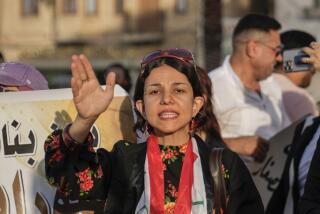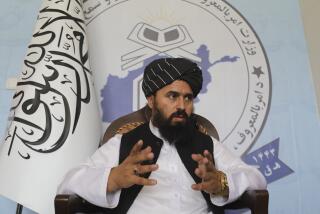Echoes of the Bad Old Days
- Share via
In Kabul this weekend, a loya jirga, or grand assembly, is meeting to debate a draft constitution for Afghanistan. The final document approved there will not only determine the shape of the Afghan state, it will also represent a test of U.S. ambitions to help build democracies in the region.
Some have suggested that Afghanistan’s constitution might provide a blueprint for the transition of power to a representative Iraqi government. But the first matter on the table is getting agreement on a constitution for Afghanistan. It won’t be easy. The process leading up to the loya jirga has been anything but smooth. Public participation has been hindered by press censorship, fighting among factions in President Hamid Karzai’s government and the resurgence of Taliban-sponsored violence. Even if the loya jirga agrees on a constitution, there are real questions about whether the proposed document will outline a proper course for the country.
Since its publication in early November, the proposed constitution has met with criticism from conservative and progressive forces. Skeptics in Afghanistan and abroad have raised questions about the draft, which declares the country an “Islamic Republic” and stipulates that no laws may contradict Islam. Critics fear that such language represents a concession to clerics who would like to reimpose a Taliban-like theocratic regime. At the same time, many Afghans, particularly in rural areas, have criticized the draft constitution for not guaranteeing the implementation of Islamic law in the country. And these are not even the most pressing problems with the constitutional process in Afghanistan.
In its current form, the constitution seems highly unlikely to yield a democratic model for export to other parts of the Muslim world -- or even to stabilize Afghanistan itself. Indeed, the drafting process suggests that this constitution will, like past Afghan constitutions, promote authoritarian rule at the expense of civil rights. Few Afghans have been informed about the secretive deliberations of the constitutional commission, whose members were appointed by Karzai. Delegates were given just a few weeks to prepare for the loya jirga, which faces extreme pressure to ratify the document and schedule presidential elections for June.
The most glaring flaw in the constitution stems from its architects’ insistence on rigidly centralizing power in the hands of a Kabul government dominated by the president. The draft constitution grants the president broad discretionary authority to declare a state of emergency. Backed by a national army, he would be equipped to impose his will beyond Kabul. In this scenario, the center would at last tame the restive “warlords” and restore order to Afghanistan, rescuing it from the status of a failed state and menace to the region and the world.
But such a prescription, under current conditions, is not a formula for stability. Its implementation would instead mean the resumption of fighting throughout Afghanistan and the further destabilization of the region. Relying on its authoritarian predecessor of 1964, the draft constitution seeks to roll back the clock to the period preceding the Marxist coup and Soviet invasion. But it ignores the fact that since then there has been a near-complete breakdown of central state authority as regional power structures have arisen.
Far from Kabul, local commanders led the struggle against the Afghan communists and the Soviets. These elites, many of them non-Pushtun, ruled large swaths of the country until the mid-1990s, when the Pushtun-dominated Taliban movement attempted to reimpose centralized authority over them. The Taliban made gains in Pushtun areas misruled by regional commanders, but non-Pushtun populations resisted their rule.
Regional commanders gained legitimacy through the jihad against the Soviets, but they also drew strength from constituencies that had long sought regional autonomy and equal rights for Afghanistan’s many ethnic, religious and linguistic groups. Thus, in the northern, western and central provinces, the jihad brought self-rule -- and ethnic mobilization -- to Tajiks, Uzbeks, Hazaras and others. These are the populations that now question the logic of a highly centralized state. Students have already protested the constitution’s designation of Pashto as the exclusive language of the national anthem and its refusal to recognize Uzbek alongside Dari and Pashto as official languages.
Where outsiders see only “warlords,” many locals see “veterans of the jihad” who now guard their interests against a predatory state seeking to roll back cultural rights and self-rule. Many Afghans outside Kabul fear a strong state once again dominated by the majority Pushtuns, who in their view have used their power since the late 19th century to oppress non-Pushtuns, often with foreign assistance. The experience of Taliban rule only reinforced such historical memories, as government soldiers slaughtered thousands of Hazaras and other ethnic minorities in the late 1990s.
The loya jirga should listen to calls for federalist institutions that distribute power and resources more fairly throughout the country. A more decentralized system might reduce competition among ethnic or regional factions for control of the national government.
International sponsors of Afghan reconstruction face a choice: They can either back Kabul’s conquest of the provinces and risk a return to civil war or seek a more creative response to historical circumstances through the creation of federal institutions. The choice is between a negotiated but loose integration of the provinces, and the forceful reconstruction of an authoritarian state dominated by Kabul.
More to Read
Sign up for Essential California
The most important California stories and recommendations in your inbox every morning.
You may occasionally receive promotional content from the Los Angeles Times.










